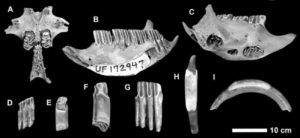
Fossilised bones that appear to have been digested by crocodiles in the Cayman Islands have revealed three new species and subspecies of mammal that roamed the island more than 300 years ago.
An expert team led by international conservation charity ZSL (Zoological Society of London), the American Museum of Natural History, and the New Mexico Museum of Natural History studied the bones from collections in British and American museums including the Florida Museum of Natural History at the University of Florida. The bones had been previously collected from caves, sinkholes and peat deposits on the Cayman Islands between the 1930s and 1990s.
Published in the Bulletin of the American Museum of Natural History today (March 4, 2019), the team describe two new large rodents (Capromys pilorides lewisi and Geocapromys caymanensis), as well as a small shrew-like mammal named Nesophontes hemicingulus. Fossil remains of the land mammal have been previously reported from the Cayman Islands, but have not been scientifically described until now.
The three mammals were unique to the Cayman Islands, existing nowhere else in the world. The scientists calculated that they would have probably become extinct around the 1700s, likely due to the arrival of European settlers and introduced mammals such as rats, cats and dogs.
Professor Samuel Turvey, Senior Research Fellow at ZSL’s Institute of Zoology, and co-author of the paper, said: “Humans are almost certainly to blame for the extinction of these newly described mammals, and this represents just the tip of the iceberg for mammal extinctions in the Caribbean. Nearly all the mammal species that used to live on these tropical islands, including all of the native Caribbean sloths and monkeys, have recently disappeared.
“It’s vitally important to understand the factors responsible for past extinctions of island species, as many threatened species today are found on islands. The handful of Caribbean mammals that still exist today are the last survivors of a unique vanished world and represent some of the world’s top conservation priorities.”
Animals described as “coneys” and “little beasts like cats,” which were probably the now-extinct rodents Capromys or Geocapromys, were seen and recorded by Sir Francis Drake when he visited the Cayman Islands in 1586. Despite the major marine barrier separating the Cayman Islands from other Caribbean lands, the extinct mammals described in this study are similar to those on Cuba, and other subspecies of Capromys pilorides still survive on Cuba today. The Cayman Islands may have originally been colonised by mammals carried across from Cuba on floating rafts of vegetation, which in some cases have been documented to float as far as 100 kilometres in less than a week.
Professor Ross MacPhee of the American Museum of Natural History’s Mammalogy Department, a co-author of the study, said: “Although one would think that the greatest days of biological field discoveries are long over, that’s very far from the case. With only one possible sighting early in the course of European expansion into the New World, these small mammals from the Cayman Islands were complete unknowns until their fossils were discovered. Their closest relatives are Cuban; how and when did they manage a 250-km journey over open water?”
The Cayman Islands
The Cayman Islands consist of three islands (Grand Cayman, Little Cayman and Cayman Brac) in the north-western Caribbean Sea, separated by significant deeps of nearly 2000m of water for more than 20 million years.
Though it is rare that islands are successfully colonised by mammals other than bats, this is not the case for the West Indies — or the islands of the Caribbean Basin. During the late Quaternary record (i.e., 0.5-1.0 million years ago) the islands comprised of nearly 130 different species, including sloths, insect eating mammals, ancient mysterious monkeys, rodents and bats.
However, due to the arrival of European humans, only 13 endemic mammal species now survive in the West Indies, along with 60 species of bat. Calculations from the study indicate that several species might have survived into present day if they had not suffered at the hands of man — altering their habitat and introducing exotic creatures over the last 500 years.
Reference:
Morgan, Gary S.; MacPhee, R. D. E.; Woods, Roseina.; Turvey, Sam. Late Quaternary fossil mammals from the Cayman Islands, West Indies. Bulletin of the American Museum of Natural History, 2019 [link]
Note: The above post is reprinted from materials provided by Zoological Society of London.










